Nixeus NX-VUE27 27" Monitor: High Resolution for the Masses
by Chris Heinonen on September 20, 2012 6:10 PM ESTDisplay Uniformity
With the primary measurements out of the way, we now turn to testing display uniformity. It's easier to get good results at the center of a display, while extending the results to the corners and edges requires a lot more effort. Let's see how uniform the Nixeus is.
When the center of the ANSI grid is set to 200 nits of brightness, the surrounding blocks are all close, though it is better at the lower section of the screen with an average of 95% of the center brightness. Once you move to the outside of the monitor the readings drop by at least 7%, falling all the way to a 17% drop off in one corner. The overall average is 89% of the center brightness, or 181 nits. This is actually pretty normal for monitors, particularly larger models, and it's only very expensive professional displays like the NEC display we reviewed that tend to do better.
Black uniformity does not mirror the white uniformity in this case, which could be due to the updated testing method, panel and backlighting uniformity, or a combination of both. The deepest blacks we get are in the corner with 0.353 nits in the upper-left, which also happens to be the darkest spot in the white uniformity testing. The brightest spot, no surprise, is in the center of the screen that measures 0.420 nits. The average black level winds up at 0.390 nits for all measurements. This is okay for black levels but certainly not outstanding.
Our contrast is more uniform across the panel, as areas with high white levels typically have high black levels as well, an indication of the backlight level in that section of the screen. The exception seems to be the upper-right section of the screen where we have higher black levels and lower white levels. I thought these were suspect and measured them multiple times, but always found the same results. The average contrast ratio for the center of the panel is 473:1 and for the outside it's 461:1, so that is fairly uniform for the whole display.
Looking at the dE uniformity of the Nixeus, it tracks really well across the whole screen. The main errors occur in the grayscale, which is what we typically see, but otherwise the numbers are almost spot on across the monitor. We do see a rise on the left side of the monitor relative to the rest of the display, likely from the lighting uniformity issues, but there aren't any extreme variances.
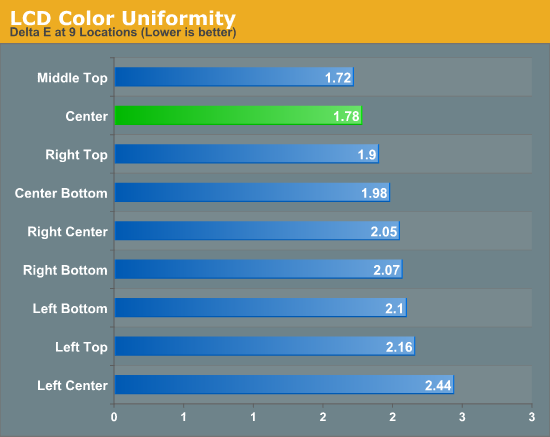
In summary, the uniformity of the Nixeus NX-VUE27 is decent and is similar to what we have seen from other non-professional 27” flat panels. The contrast ratio leaves a good bit to be desired, as the black floor is not what it should be in this display. I could enable the Dynamic Contrast mode to help that, but since it has only one setting and is very noticeable (not in a good way), I wasn’t inclined to enable it.


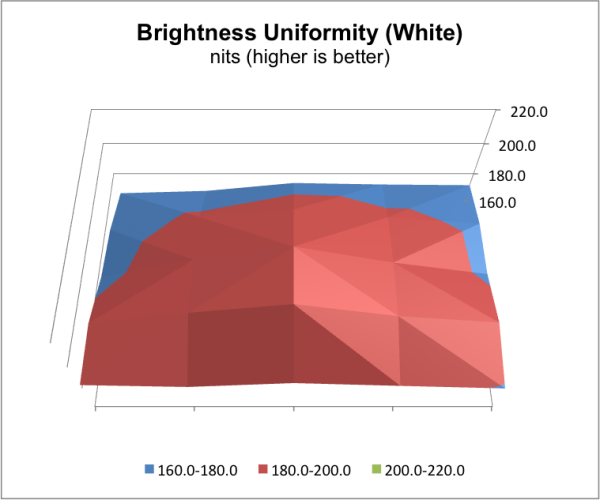
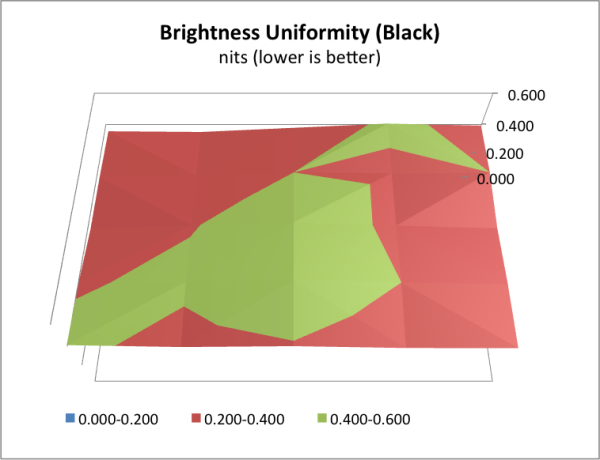
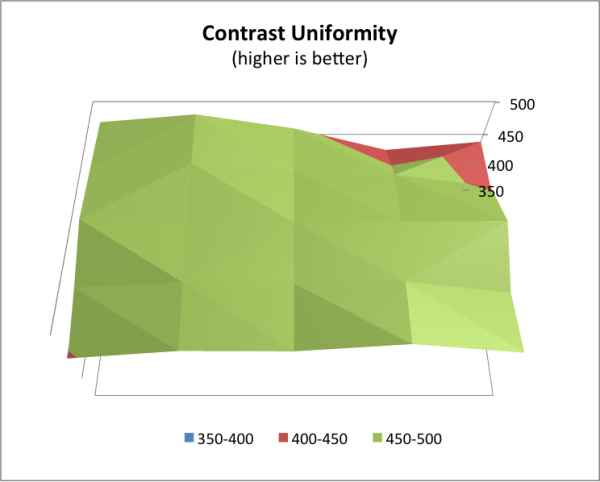
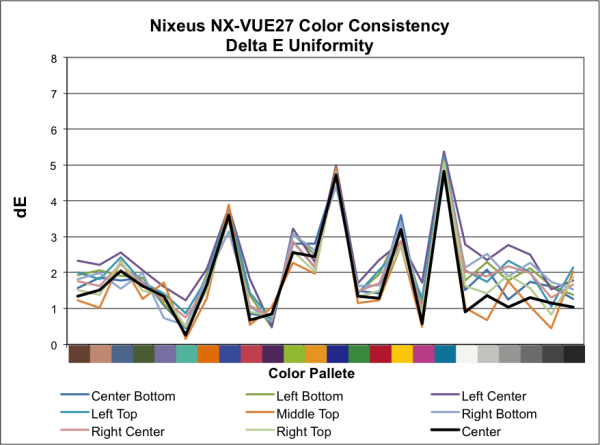
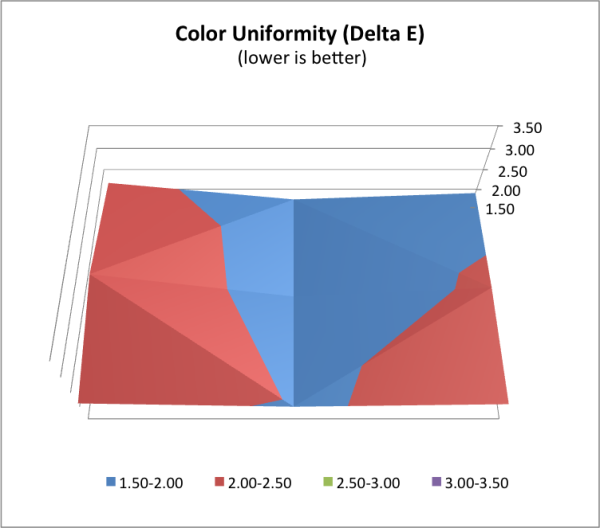








66 Comments
View All Comments
magreen - Thursday, September 20, 2012 - link
Especially given that there appears to be a real surplus of compute power in computers these days. The vast majority of users have no need for the compute power an i7 can deliver nor what most discrete GPUs can deliver. It's time to harness that power to finally give us resolution independent displays!peterfares - Thursday, September 20, 2012 - link
Windows fully supports DPI scaling since Vista. Most Microsoft programs fully support it and a few third party ones do, too. You can also try forcing high DPI mode on unsupported programs and see which ones work. Otherwise you can run them at their original pixel size or you can pixel scale them.Microsoft made a small push for higher DPI screens back during Vista's launch (along with hybrid hard drives) and it's only now when screens are finally moving up in DPI (look at the new laptops and tablets with 13" 1080p screens). Hybrid hard drives are also coming into play, though it's a bit late since SSDs are becoming big and cheap enough to completely replace them. Vista was just far ahead of its time.
cosmotic - Friday, September 21, 2012 - link
"vista was just far ahead of its time"Yeah, *thats* what vista was.
Malphas - Monday, September 24, 2012 - link
Actually it was, try Vista again today and you'll find it a near identical experience to Windows 7. The reason it was so awful at the time was due to underpowered hardware (made worse by the Vista Ready scheme Microsoft stupidly went along with to appease OEMs), incompatible hardware and software, buggy third party drivers, software that didn't play nice with UAC, etc. The actual OS itself is sound and again only cosmetically different from Windows 7, which received near universal praise.Penti - Friday, September 21, 2012 - link
Readyboost is still horrible and should die, seriously just give me an mSATA SSD + HDD if cheap storage is needed instead of 5400 rpm drives and small sub 64GB SSDs for caching. It's worse then a fast HDD. DPI-scaling is by no means an nice and clean way of scaling elements in Windows, not even all Microsoft apps support it. Though it's standard to have it scale on OEM-PCs since a long time now. Metro still scales horrible though.madmilk - Thursday, September 27, 2012 - link
It supports it in basically the same way the retina Macbook does (assuming Vista-style scaling): show natively high-res apps at full resolution, and scale up the rest.The difference is, Microsoft hasn't gone out and made noise about it, so pretty much everyone's apps are just using ugly scaling.
Sabresiberian - Friday, September 21, 2012 - link
"Resolution" has been perverted since LCDs came out. It used to be tied to pixel density. So, correctly speaking cell phones already have higher resolutions than monitors.;)
jeremyshaw - Thursday, September 20, 2012 - link
Hello,I've noticed you mentioned HDMI 1.4 support in the specifications list. Does that mean an AMD GCN or Intel Ivy Bridge (do the Ivy Bridge drivers support that, yet?) can output, via a HDMI output, a 2560x**** image at 60Hz?
peterfares - Thursday, September 20, 2012 - link
It's been stated that this display supports those resolutions over HDMI as long as you have a device capable of sourcing it. I don't know what can source it, if anything, yet.atotroadkill - Thursday, September 20, 2012 - link
From what I can find on the web, if you are using the CPU's embedded GPU for the HDMI output then no - only displayport can.To power 2560x1440 over HDMI you may need a descrete Nvidia 600 series card.